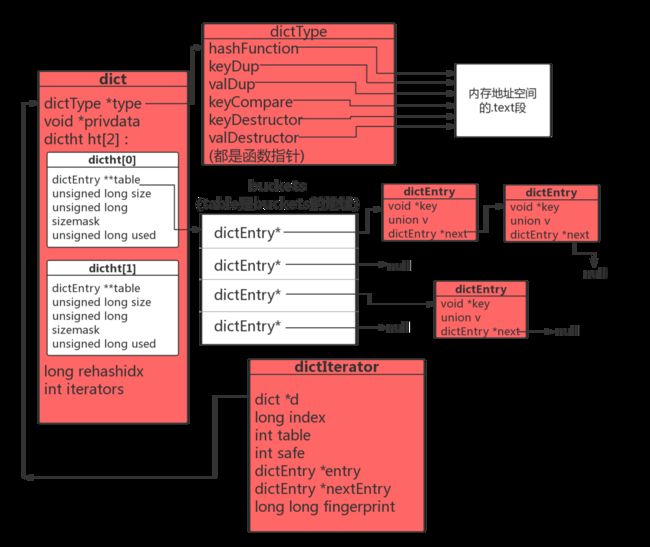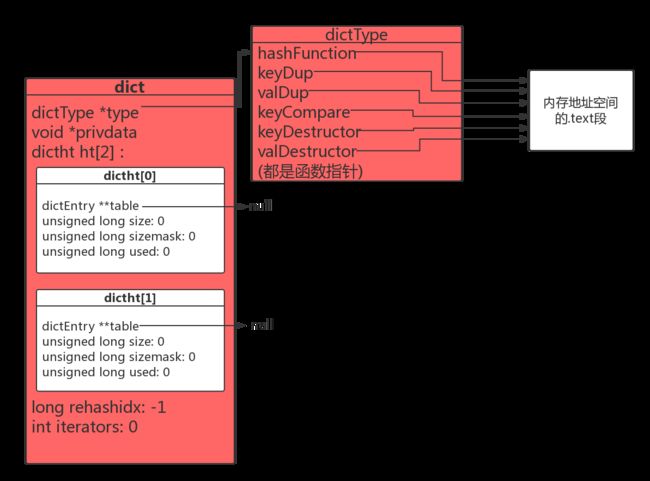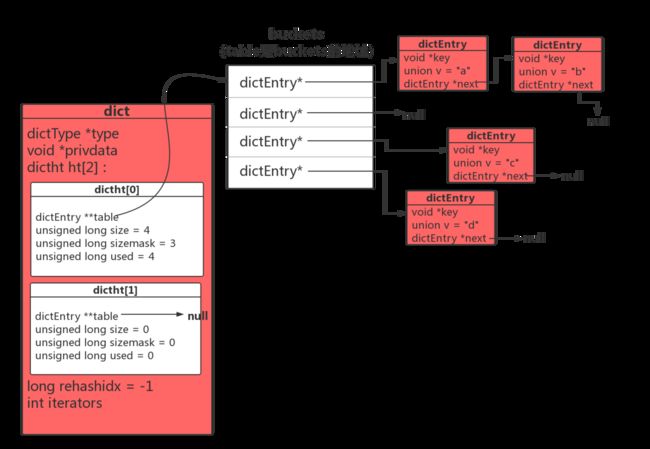- 一、什么是dict
- 二、Redis dict数据结构
- hash算法
- 三、dict的基本操作
- 创建Dict
- 新增 - dictAdd
- 删除 - dictDelete
- 修改 - dictReplace
- 查询 - dictFind
- Rehash
- 什么是Rehash
- 什么时候会触发Rehash
- Rehash的过程
- Rehash的方式
- 安全/非安全迭代器
- dictIterator定义
- dictGetIterator:创建一个迭代器
- dictNext:迭代一个dictEntry节点
- 参考资料
一、什么是dict
dict (dictionary 字典),通常的存储结构是Key-Value形式的,通过Hash函数对key求Hash值来确定Value的位置,因此也叫Hash表,是一种用来解决算法中查找问题的数据结构,默认的算法复杂度接近O(1),Redis本身也叫Remote Dictionary Server(远程字典服务器),其实也就是一个大字典,它的key通常来说是String类型的,但是Value可以是
String、Set、ZSet、Hash、List等不同的类型,下面我们看下dict的数据结构定义。
二、Redis Dict数据结构
从上图可以看出与dict相关的关键数据结构有三个,分别是:
-
dict是Redis中的字典结构,包含两个dictht。 -
dictht表示一个Hash表。 -
dictEntry是Redis中的字典结构,包含两个dictht。
dictEntry代码如下
// redis 5.0.2
typedef struct dictEntry {
void *key; //key void*表示任意类型指针
union {//联合体中对于数字类型提供了专门的类型优化
void *val;
uint64_t u64;
int64_t s64;
double d;
} v;
struct dictEntry *next; //next指针,用拉链法解决哈希冲突
} dictEntry;
dictht代码如下
// redis 5.0.2
/* This is our hash table structure. Every dictionary has two of this as we
* implement incremental rehashing, for the old to the new table. */
typedef struct dictht {
dictEntry **table; //数组指针,每个元素都是一个指向dictEntry的指针
unsigned long size; //表示这个dictht已经分配空间的大小,大小总是2^n
unsigned long sizemask;//sizemask = size - 1; 是用来求hash值的掩码,为2^n-1
unsigned long used; //目前已有的元素数量
} dictht;
dict代码如下
typedef struct dict {
dictType *type; //type中定义了对于Hash表的操作函数,比如Hash函数,key比较函数等
void *privdata; //privdata是可以传递给dict的私有数据
dictht ht[2]; //每一个dict都包含两个dictht,一个用于rehash
long rehashidx; /* rehashing not in progress if rehashidx == -1 */
unsigned long iterators; /* number of iterators currently running */
} dict;
typedef struct dictType {
uint64_t (*hashFunction)(const void *key);// 计算hash值的函数
void *(*keyDup)(void *privdata, const void *key);// 键复制
void *(*valDup)(void *privdata, const void *obj);// 值复制
int (*keyCompare)(void *privdata, const void *key1, const void *key2);// 键比较
void (*keyDestructor)(void *privdata, void *key);// 键销毁
void (*valDestructor)(void *privdata, void *obj);// 值销毁
} dictType;
其实通过上面的三个数据结构,已经可以大概看出dict的组成,数据(Key-Value)存储在每一个dictEntry节点;然后一条Hash表就是一个dictht结构,里面标明了Hash表的size,used等信息;最后每一个Redis的dict结构都会默认包含两个dictht,如果有一个Hash表满足特定条件需要扩容,则会申请另一个Hash表,然后把元素ReHash过来,ReHash的意思就是重新计算每个Key的Hash值,然后把它存放在第二个Hash表合适的位置,但是这个操作在Redis中并不是集中式一次完成的,而是在后续的增删改查过程中逐步完成的,这个叫渐进式ReHash,我们后文会专门讨论。
hash算法
redis内置2种hash算法
dictGenHashFunction,对字符串进行hash
-
dictGenCaseHashFunction,对字符串进行hash,不区分大小写
/* The default hashing function uses SipHash implementation * in siphash.c. */ uint64_t siphash(const uint8_t *in, const size_t inlen, const uint8_t *k); uint64_t siphash_nocase(const uint8_t *in, const size_t inlen, const uint8_t *k); uint64_t dictGenHashFunction(const void *key, int len) { return siphash(key,len,dict_hash_function_seed); } uint64_t dictGenCaseHashFunction(const unsigned char *buf, int len) { return siphash_nocase(buf,len,dict_hash_function_seed); }
三、Dict的基本操作
创建Dict
/* Reset a hash table already initialized with ht_init().
* NOTE: This function should only be called by ht_destroy(). */
static void _dictReset(dictht *ht)
{
ht->table = NULL;
ht->size = 0;
ht->sizemask = 0;
ht->used = 0;
}
/* Create a new hash table */
dict *dictCreate(dictType *type,
void *privDataPtr)
{
dict *d = zmalloc(sizeof(*d));
_dictInit(d,type,privDataPtr);
return d;
}
/* Initialize the hash table */
int _dictInit(dict *d, dictType *type,
void *privDataPtr)
{
_dictReset(&d->ht[0]);
_dictReset(&d->ht[1]);
d->type = type;
d->privdata = privDataPtr;
d->rehashidx = -1;
d->iterators = 0;
return DICT_OK;
}
需要注意的是创建初始化一个dict时并没有为buckets分配空间,table是赋值为null的。只有在往dict里添加dictEntry节点时才会为buckets分配空间,真正意义上创建一张hash表。
执行dictCreate后会得到如下布局:
新增 - dictAdd
#define dictSetVal(d, entry, _val_) do { \
if ((d)->type->valDup) \
(entry)->v.val = (d)->type->valDup((d)->privdata, _val_); \
else \
(entry)->v.val = (_val_); \
} while(0)
/* Add an element to the target hash table */
int dictAdd(dict *d, void *key, void *val)
{
dictEntry *entry = dictAddRaw(d,key,NULL);//只在buckets的某个索引里新建一个dictEntry并调整链表的位置,只设置key,不设置不设置val
if (!entry) return DICT_ERR;
dictSetVal(d, entry, val);
return DICT_OK;
}
/* Low level add or find:
* This function adds the entry but instead of setting a value returns the
* dictEntry structure to the user, that will make sure to fill the value
* field as he wishes.
*
* This function is also directly exposed to the user API to be called
* mainly in order to store non-pointers inside the hash value, example:
*
* entry = dictAddRaw(dict,mykey,NULL);
* if (entry != NULL) dictSetSignedIntegerVal(entry,1000);
*
* Return values:
*
* If key already exists NULL is returned, and "*existing" is populated
* with the existing entry if existing is not NULL.
*
* If key was added, the hash entry is returned to be manipulated by the caller.
*/
dictEntry *dictAddRaw(dict *d, void *key, dictEntry **existing)
{
long index;
dictEntry *entry;
dictht *ht;
if (dictIsRehashing(d)) _dictRehashStep(d);//判断是否是在rehash,如果是rehash会渐进式reash
/* Get the index of the new element, or -1 if
* the element already exists. */
if ((index = _dictKeyIndex(d, key, dictHashKey(d,key), existing)) == -1)
return NULL;
/* Allocate the memory and store the new entry.
* Insert the element in top, with the assumption that in a database
* system it is more likely that recently added entries are accessed
* more frequently. */
ht = dictIsRehashing(d) ? &d->ht[1] : &d->ht[0];//如果正在rehash的话存第二个hashtable里面
entry = zmalloc(sizeof(*entry));
entry->next = ht->table[index];
ht->table[index] = entry;
ht->used++;
/* Set the hash entry fields. */
dictSetKey(d, entry, key);
return entry;
}
主要分为以下几个步骤:
- 根据key的hash值找到应该存放的位置(buckets索引)。
- 若dict是刚创建的还没有为bucekts分配内存,则会在找位置(_dictKeyIndex)时调用_dictExpandIfNeeded,为dictht[0]expand一个大小为4的buckets;若dict正好到了expand的时机,则会expand它的dictht[1],并将rehashidx置为0打开rehash开关,_dictKeyIndex返回的会是dictht[1]的索引。
- 申请一个dictEntry大小的内存插入到buckets对应索引下的链表头部,并给dictEntry设置next指针和key。
- 为dictEntry设置value
删除 - dictDelete
#define dictCompareKeys(d, key1, key2) \
(((d)->type->keyCompare) ? \
(d)->type->keyCompare((d)->privdata, key1, key2) : \
(key1) == (key2))
/* Remove an element, returning DICT_OK on success or DICT_ERR if the
* element was not found. */
int dictDelete(dict *ht, const void *key) {
return dictGenericDelete(ht,key,0) ? DICT_OK : DICT_ERR;
}
/* Search and remove an element. This is an helper function for
* dictDelete() and dictUnlink(), please check the top comment
* of those functions. */
static dictEntry *dictGenericDelete(dict *d, const void *key, int nofree) {
uint64_t h, idx;
dictEntry *he, *prevHe;
int table;
if (d->ht[0].used == 0 && d->ht[1].used == 0) return NULL;
if (dictIsRehashing(d)) _dictRehashStep(d);
h = dictHashKey(d, key);
for (table = 0; table <= 1; table++) {
idx = h & d->ht[table].sizemask;
he = d->ht[table].table[idx];//找到key对应的bucket索引
prevHe = NULL;
while(he) {
if (key==he->key || dictCompareKeys(d, key, he->key)) {
/* Unlink the element from the list */
if (prevHe)
prevHe->next = he->next;
else
d->ht[table].table[idx] = he->next;
if (!nofree) {
dictFreeKey(d, he);
dictFreeVal(d, he);
zfree(he);
}
d->ht[table].used--;
return he;
}
prevHe = he;
he = he->next;
}
if (!dictIsRehashing(d)) break;
}
return NULL; /* not found */
}
/* Clear & Release the hash table */
void dictRelease(dict *d)
{
_dictClear(d,&d->ht[0],NULL);
_dictClear(d,&d->ht[1],NULL);
zfree(d);
}
修改 - dictReplace
/* Add or Overwrite:
* Add an element, discarding the old value if the key already exists.
* Return 1 if the key was added from scratch, 0 if there was already an
* element with such key and dictReplace() just performed a value update
* operation. */
int dictReplace(dict *d, void *key, void *val)
{
dictEntry *entry, *existing, auxentry;
/* Try to add the element. If the key
* does not exists dictAdd will succeed. */
entry = dictAddRaw(d,key,&existing);
if (entry) {
dictSetVal(d, entry, val);
return 1;
}
/* Set the new value and free the old one. Note that it is important
* to do that in this order, as the value may just be exactly the same
* as the previous one. In this context, think to reference counting,
* you want to increment (set), and then decrement (free), and not the
* reverse. */
auxentry = *existing;
dictSetVal(d, existing, val);
dictFreeVal(d, &auxentry);
return 0;
}
查询 - dictFind
dictEntry *dictFind(dict *d, const void *key)
{
dictEntry *he;
uint64_t h, idx, table;
if (d->ht[0].used + d->ht[1].used == 0) return NULL; /* dict is empty */
if (dictIsRehashing(d)) _dictRehashStep(d);
h = dictHashKey(d, key);
for (table = 0; table <= 1; table++) {
idx = h & d->ht[table].sizemask;
he = d->ht[table].table[idx];
while(he) {
if (key==he->key || dictCompareKeys(d, key, he->key))
return he;
he = he->next;
}
if (!dictIsRehashing(d)) return NULL;
}
return NULL;
}
Rehash
什么是Rehash
随着操作的不断执行,hash表保存的键值对会逐渐的增多或者减少,这时就会暴露一些问题。如果hash表很大,但是键值对太少,也就是hash表的负载(dictht->used/dictht->size)太小,就会有大量的内存浪费;如果hash表的负载太大,就会影响字典的查找效率。这时候就需要进行rehash将hash表的负载控制在一个合理的范围。
什么时候会触发Rehash
当调用dictAdd为dict添加一个dictEntry节点时候,会_dictKeyIndex找到应该放置在buckets的哪个索引里,在这里会调用_dictExpandIfNeeded检查当前哈希表的空间是需要扩充(Rehash),若满足条件:dictht[0]的dictEntry节点数/buckets的索引数>=1则调用dictExpand,若dictEntry节点数/buckets的索引数>=dict_force_resize_ratio(默认是5),则强制执行dictExpand扩充dictht[1]。
/* Returns the index of a free slot that can be populated with
* a hash entry for the given 'key'.
* If the key already exists, -1 is returned
* and the optional output parameter may be filled.
*
* Note that if we are in the process of rehashing the hash table, the
* index is always returned in the context of the second (new) hash table. */
static long _dictKeyIndex(dict *d, const void *key, uint64_t hash, dictEntry **existing)
{
unsigned long idx, table;
dictEntry *he;
if (existing) *existing = NULL;
/* Expand the hash table if needed */
if (_dictExpandIfNeeded(d) == DICT_ERR)
return -1;
for (table = 0; table <= 1; table++) {
idx = hash & d->ht[table].sizemask;
/* Search if this slot does not already contain the given key */
he = d->ht[table].table[idx];
while(he) {
if (key==he->key || dictCompareKeys(d, key, he->key)) {
if (existing) *existing = he;
return -1;
}
he = he->next;
}
if (!dictIsRehashing(d)) break;
}
return idx;
}
/* Expand the hash table if needed */
//判断dictht[1]是否需要扩充(并将dict调整为正在rehash状态);若dict刚创建,则扩充dictht[0]
static int _dictExpandIfNeeded(dict *d)
{
/* Incremental rehashing already in progress. Return. */
if (dictIsRehashing(d)) return DICT_OK; //如果正在ReHash,那直接返回OK,其实也表明申请了空间不久。
/* If the hash table is empty expand it to the initial size. */
if (d->ht[0].size == 0) return dictExpand(d, DICT_HT_INITIAL_SIZE);//如果 0 号哈希表的大小为0,表示还未创建,按照默认大小`DICT_HT_INITIAL_SIZE=4`去创建
/* If we reached the 1:1 ratio, and we are allowed to resize the hash
* table (global setting) or we should avoid it but the ratio between
* elements/buckets is over the "safe" threshold, we resize doubling
* the number of buckets. */
//如果满足 0 号哈希表used>size &&(dict_can_resize为1 或者 used/size > 5) 那就默认扩两倍大小
if (d->ht[0].used >= d->ht[0].size &&
(dict_can_resize ||
d->ht[0].used/d->ht[0].size > dict_force_resize_ratio))
{
return dictExpand(d, d->ht[0].used*2);
}
return DICT_OK;
}
/* Expand or create the hash table */
//三个功能:
//1.为刚初始化的dict的dictht[0]分配table(buckets)
//2.为已经达到rehash要求的dict的dictht[1]分配一个更大(下一个2^n)的table(buckets),并将rehashidx置为0
//3.为需要缩小bucket的dict分配一个更小的buckets,并将rehashidx置为0(打开rehash开关)
int dictExpand(dict *d, unsigned long size)
{
/* the size is invalid if it is smaller than the number of
* elements already inside the hash table */
if (dictIsRehashing(d) || d->ht[0].used > size)
return DICT_ERR;
dictht n; /* the new hash table */
unsigned long realsize = _dictNextPower(size);////从4开始找大于等于size的最小2^n作为新的slot数量
/* Rehashing to the same table size is not useful. */
if (realsize == d->ht[0].size) return DICT_ERR;
/* Allocate the new hash table and initialize all pointers to NULL */
n.size = realsize;
n.sizemask = realsize-1;
n.table = zcalloc(realsize*sizeof(dictEntry*));
n.used = 0;
/* Is this the first initialization? If so it's not really a rehashing
* we just set the first hash table so that it can accept keys. */
if (d->ht[0].table == NULL) {//刚创建的dict
d->ht[0] = n;//为d->ht[0]赋值
return DICT_OK;
}
/* Prepare a second hash table for incremental rehashing */
d->ht[1] = n;
d->rehashidx = 0;//设置为0表示开始从0号bucket Rehash
return DICT_OK;
}
Rehash的过程
假设一个dict已经有4个dictEntry节点(value分别为"a","b","c","d"),根据key的不同,存放在buckets的不同索引下。
现在如果我们想添加一个dictEntry,由于d->ht[0].used >= d->ht[0].size (4>=4),满足了扩充dictht[1]的条件,会执行dictExpand。根据扩充规则,dictht[1]的buckets会扩充到8个槽位。
之后再将要添加的dictEntry加入到dictht[1]的buckets中的某个索引下,不过这个操作不属于dictExpand,不展开了。
扩充之后的dict的成员变量rehashidx被赋值为0,此后每次CRUD都会执行一次被动rehash把dictht[0]的buckets中的一个链表迁移到dictht[1]中,直到迁移完毕。
Rehash的方式
-
主动Rehash,一毫秒执行一次
/* Rehash for an amount of time between ms milliseconds and ms+1 milliseconds */ int dictRehashMilliseconds(dict *d, int ms) { long long start = timeInMilliseconds(); int rehashes = 0; while(dictRehash(d,100)) {//每次最多执行buckets的100个链表rehash rehashes += 100; if (timeInMilliseconds()-start > ms) break; } return rehashes; } 被动Rehash,字典的增删改查(CRUD)调用dictAdd,dicFind,dictDelete,dictGetRandomKey等函数时,会调用_dictRehashStep,迁移buckets中的一个非空bucket
if (dictIsRehashing(d)) _dictRehashStep(d);
rehash函数
/* Performs N steps of incremental rehashing. Returns 1 if there are still
* keys to move from the old to the new hash table, otherwise 0 is returned.
*
* Note that a rehashing step consists in moving a bucket (that may have more
* than one key as we use chaining) from the old to the new hash table, however
* since part of the hash table may be composed of empty spaces, it is not
* guaranteed that this function will rehash even a single bucket, since it
* will visit at max N*10 empty buckets in total, otherwise the amount of
* work it does would be unbound and the function may block for a long time. */
int dictRehash(dict *d, int n) {
//int empty_visits = n*10; empty_visits表示每次最多跳过10倍步长的空桶
//(一个桶就是ht->table数组的一个位置),然后当我们找到一个非空的桶时,
// 就将这个桶中所有的key全都ReHash到 1 号Hash表。最后每次都会判断是否将所有的key全部ReHash了,
// 如果已经全部完成,就释放掉ht[0],然后将ht[1]变成ht[0]。
int empty_visits = n*10; /* Max number of empty buckets to visit. */
if (!dictIsRehashing(d)) return 0;
while(n-- && d->ht[0].used != 0) {//遍历n个bucket,ht[0]中还有dictEntry
dictEntry *de, *nextde;
/* Note that rehashidx can't overflow as we are sure there are more
* elements because ht[0].used != 0 */
assert(d->ht[0].size > (unsigned long)d->rehashidx);
while(d->ht[0].table[d->rehashidx] == NULL) {
//当前bucket为空时跳到下一个bucket并且
d->rehashidx++;
if (--empty_visits == 0) return 1;
}
//直到当前bucket不为空bucket时
de = d->ht[0].table[d->rehashidx];
/* Move all the keys in this bucket from the old to the new hash HT */
while(de) {//把当前bucket的所有ditcEntry节点都移到ht[1]
uint64_t h;
nextde = de->next;
/* Get the index in the new hash table */
//hash函数算出的值& 新hashtable(buckets)的sizemask,保证h会小于新buckets的size
h = dictHashKey(d, de->key) & d->ht[1].sizemask;
de->next = d->ht[1].table[h];//插入到链表的最前面!省时间
d->ht[1].table[h] = de;
d->ht[0].used--;
d->ht[1].used++;
de = nextde;
}
d->ht[0].table[d->rehashidx] = NULL;//当前bucket已经完全移走
d->rehashidx++;
}
/* Check if we already rehashed the whole table... */
if (d->ht[0].used == 0) {
zfree(d->ht[0].table);//释放掉ht[0].table的内存(buckets)
d->ht[0] = d->ht[1];//浅复制,table只是一个地址,直接给ht[0]就好
_dictReset(&d->ht[1]);//ht[1]的table置空
d->rehashidx = -1;
return 0;
}
/* More to rehash... */
return 1;
}
安全/非安全迭代器
safe迭代器:用户在迭代过程中可以对元素进行CRUD
undsafe迭代器:用户在迭代过程中禁止对元素进行CRUD
redis在dict结构里增加一个iterator成员,用来表示绑定在当前dict上的safe迭代器数量,dict每次CRUD执行_dictRehashStep时判断一下是否有绑定safe迭代器,如果有则不进行rehash以免扰乱迭代器的迭代,这样safe迭代时字典就可以正常进行CRUD操作了。
static void _dictRehashStep(dict *d) {
if (d->iterators == 0) dictRehash(d,1);
}
unsafe迭代器在执行迭代过程中不允许对dict进行其他操作,如何保证这一点呢?
redis在第一次执行迭代时会用dictht[0]、dictht[1]的used、size、buckets地址计算一个fingerprint(指纹),在迭代结束后释放迭代器时再计算一遍fingerprint看看是否与第一次计算的一致,若不一致则用断言终止进程,生成指纹的函数如下:
//unsafe迭代器在第一次dictNext时用dict的两个dictht的table、size、used进行hash算出一个结果
//最后释放iterator时再调用这个函数生成指纹,看看结果是否一致,不一致就报错.
//safe迭代器不会用到这个
long long dictFingerprint(dict *d) {
long long integers[6], hash = 0;
int j;
integers[0] = (long) d->ht[0].table;//把指针类型转换成long
integers[1] = d->ht[0].size;
integers[2] = d->ht[0].used;
integers[3] = (long) d->ht[1].table;
integers[4] = d->ht[1].size;
integers[5] = d->ht[1].used;
/* We hash N integers by summing every successive integer with the integer
* hashing of the previous sum. Basically:
*
* Result = hash(hash(hash(int1)+int2)+int3) ...
*
* This way the same set of integers in a different order will (likely) hash
* to a different number. */
for (j = 0; j < 6; j++) {
hash += integers[j];
/* For the hashing step we use Tomas Wang's 64 bit integer hash. */
hash = (~hash) + (hash << 21); // hash = (hash << 21) - hash - 1;
hash = hash ^ (hash >> 24);
hash = (hash + (hash << 3)) + (hash << 8); // hash * 265
hash = hash ^ (hash >> 14);
hash = (hash + (hash << 2)) + (hash << 4); // hash * 21
hash = hash ^ (hash >> 28);
hash = hash + (hash << 31);
}
return hash;
}
dictIterator定义
typedef struct dictIterator {
dict *d;
long index;//当前buckets索引,buckets索引类型是unsinged long,而这个初始化会是-1,所以long
int table, safe;//table是ht的索引只有0和1,safe是安全迭代器和不安全迭代器
//安全迭代器就等于加了一个锁在dict,使dict在CRUD时ditcEntry不能被动rehash
dictEntry *entry, *nextEntry;//当前hash节点以及下一个hash节点
/* unsafe iterator fingerprint for misuse detection. */
long long fingerprint;//dict.c里的dictFingerprint(),不安全迭代器相关
} dictIterator;
dictGetIterator:创建一个迭代器
//默认是new一个unsafe迭代器
dictIterator *dictGetIterator(dict *d)//获取一个iterator就是为这个dict new一个迭代器
{
//不设置成员变量fingerprint,在dictNext的时候才设置。
dictIterator *iter = zmalloc(sizeof(*iter));
iter->d = d;
iter->table = 0;
iter->index = -1;
iter->safe = 0;
iter->entry = NULL;
iter->nextEntry = NULL;
return iter;
}
dictIterator *dictGetSafeIterator(dict *d) {
dictIterator *i = dictGetIterator(d);
i->safe = 1;
return i;
}
dictNext:迭代一个dictEntry节点
虽然safe迭代器会禁止rehash,但在迭代时有可能已经rehash了一部分,所以迭代器也会遍历在dictht[1]中的所有dictEntry。
参考资料
Redis源码分析(dict)
redis源码解读(三):基础数据结构之dict
Redis源码分析(dict)



